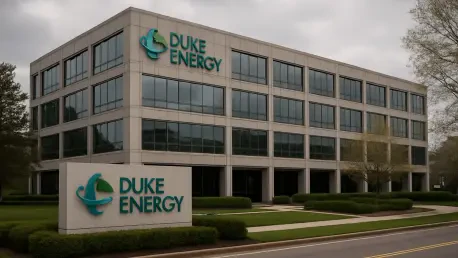Setting the Stage for a Transformative Utility Shift
In the heart of the Carolinas, where energy demand continues to climb amid a rapidly evolving power landscape, Duke Energy, based in Charlotte, North Carolina, has proposed a monumental merger of its two regional utilities—Duke Energy Carolinas (DEC) and Duke Energy Progress (DEP). This strategic consolidation into a single entity under the DEC banner aims to reshape the utility market by unlocking significant cost savings and operational efficiencies. With a target completion date of January 1, 2027, pending regulatory approvals from state bodies in North Carolina and South Carolina as well as the Federal Energy Regulatory Commission, this move has captured the attention of industry watchers and stakeholders alike.
The importance of this analysis lies in understanding how such a merger could redefine market dynamics for utilities in the Carolinas, a region grappling with increasing grid complexity and a shift toward diversified energy sources. As customer bases expand and renewable integration becomes paramount, the proposed unification signals a potential turning point for cost management and service delivery. This examination dives into current market trends, dissects the financial and operational projections of the merger, and explores the broader implications for the energy sector in this pivotal area.
Unpacking Market Trends and Projections in Carolinas Utilities
Historical Context and Current Market Pressures
The utility market in the Carolinas has long been shaped by Duke Energy’s dominant presence, with DEC and DEP serving millions of customers across North Carolina and South Carolina. A notable benchmark was set over a decade ago when Duke Energy merged with Progress Energy, achieving nearly $1 billion in savings through coordinated operations. However, regulatory barriers have since restricted full integration, maintaining separate corporate structures and rate schedules that limit deeper efficiencies. This historical fragmentation underscores the market’s readiness for a more unified approach to tackle modern challenges.
Today, the Carolinas face mounting pressures from surging energy demand and the need to incorporate renewable resources like solar and wind into an aging grid infrastructure. These factors have created a competitive environment where utilities must optimize costs while meeting stricter environmental mandates. Duke Energy’s proposal to consolidate DEC and DEP reflects a strategic response to these market forces, aiming to streamline operations and position itself as a leader in navigating the complexities of a transitioning energy sector.
Financial Projections: A $3.2 Billion Savings Opportunity
Central to the market analysis is the financial forecast tied to Duke Energy’s merger plan, which projects savings of $3.2 billion by 2038. Approximately 97% of these savings are expected to derive from enhanced system planning and operational improvements, such as optimized placement of generation and transmission assets. The remaining portion will come from administrative streamlining, reducing overhead costs across a unified entity. Such projections suggest a significant shift in cost structures, potentially setting a new standard for utility economics in the region.
However, the upfront cost of this consolidation, estimated at $143 million, introduces a layer of financial risk that could impact short-term market perceptions. Investors and regulators will likely scrutinize how quickly these initial expenses can be offset by long-term gains. If successful, the merger could stabilize operational costs, offering a buffer against fluctuating fuel prices and providing a model for other utilities facing similar fiscal challenges in competitive markets.
Operational Impacts and Grid Reliability Trends
From an operational standpoint, merging DEC, with its 20,800 MW capacity serving 2.9 million customers, and DEP, with 13,800 MW for 1.8 million customers, promises to enhance grid reliability across the Carolinas. A unified utility can better manage distributed energy resources, particularly solar, by reducing curtailments caused by oversupply or congestion. This capability aligns with broader market trends favoring resilience and adaptability in power distribution as renewable penetration grows.
Moreover, a single operational framework could simplify resource allocation, allowing for more strategic infrastructure investments across a wider geographic footprint. This trend toward operational coherence may influence market expectations, pushing competitors to adopt similar consolidation strategies. Yet, the challenge remains in ensuring that rural and urban areas receive equitable attention under a centralized system, a factor that could shape customer satisfaction and market stability in the coming years.
Customer Cost Dynamics and Market Equity Concerns
A critical market consideration is the uneven impact of the merger on customer costs across the Carolinas. Early projections indicate that South Carolina retail customers might face higher initial costs compared to benefits, creating a potential disparity in market fairness. To address this, Duke Energy has rolled out a “Share the Benefits” plan, where North Carolina retail customers will contribute $25 million annually for six years, and wholesale customers will provide $55 million each year for five years to offset burdens in South Carolina.
This initiative highlights a growing trend in utility markets to balance regional disparities through innovative cost-sharing mechanisms. While it aims to secure regulatory approval and maintain market harmony, it also raises questions about long-term equity and whether temporary measures will suffice. Market analysts will be keen to observe if this approach sets a precedent for handling customer cost variations in future utility consolidations, potentially influencing rate structures and consumer trust across the sector.
Regulatory and Regional Market Challenges
The regulatory landscape presents another layer of complexity to this merger, as approvals from multiple state and federal bodies are required. Blending retail rates over time for DEC and DEP customers will be a delicate process, with market implications for how uniform pricing is perceived in diverse communities. Regulatory oversight must balance the push for efficiency with the need to protect local interests, a dynamic that could shape market confidence in Duke Energy’s strategy.
Regional differences between North Carolina and South Carolina further complicate the market outlook, as unique energy needs and grid challenges vary widely. A consolidated utility risks prioritizing urban centers over rural areas, potentially disrupting market equilibrium if not carefully managed. Monitoring how regulators address these regional nuances will provide valuable insights into the feasibility of large-scale utility mergers in fragmented markets, setting benchmarks for future industry moves.
Reflecting on Market Insights and Strategic Pathways
Looking back, the analysis of Duke Energy’s proposed merger of DEC and DEP revealed a compelling intersection of financial ambition and operational necessity within the Carolinas utility market. The projected $3.2 billion in savings by 2038 stood out as a transformative potential, while challenges like upfront costs and customer disparities underscored the intricacies of market consolidation. The broader trend toward efficiency and adaptability in the face of growing energy demand and renewable integration framed this merger as a pivotal case study for the sector.
Moving forward, stakeholders are encouraged to prioritize transparent communication with regulators to navigate approval hurdles and build public trust. Utilities contemplating similar strategies could draw lessons from the “Share the Benefits” plan, adapting cost-sharing models to their own markets. Additionally, investing in community engagement to address regional concerns offers a pathway to mitigate opposition and ensure equitable outcomes. This merger, if realized, has the potential to redefine market expectations, urging industry players to innovate while safeguarding consumer interests in an ever-evolving energy landscape.









